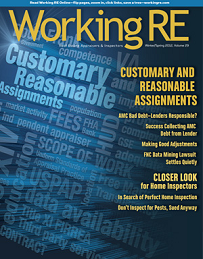
|
Published by OREP, E&O Insurance Experts | June 20, 2012 | Vol. 254 |

|
> Blogs
> Leave Comments Below |
This article explains how to make appropriate
and reasonable adjustments for residential properties, both single family
and individual condominium units.
Editor’s Note: Whether you are appraising a single family residence or a condominium unit, if your adjustments are either not supported or not reasonable, your value conclusion could be totally wrong.
Making Reasonable
and Appropriate Adjustments
By Philip G. Spool, ASA
My last article discussed choosing comparable
sales in a tough market. As was discussed in that article, in today’s
market, it is very difficult to obtain comparable sales and listings that
best reflect comparison to the subject. Some sales and/or listings might be
older but more similar to the subject; others may be further away in a
similar substitute neighborhood. Once you select your comparable sales, the
next step is to make adjustments to them.
Whether you are appraising a single family residence or a condominium unit,
if your adjustments are either not supported or not reasonable, your value
conclusion could be totally wrong. This article explains how to make
appropriate and reasonable adjustments for residential properties, both
single family and individual condominium units.
Adjustments: Fact or Opinion?
Most adjustments are considered “opinion.” Therefore, anyone can have a
difference of opinion as to the amount of an adjustment. However, all
adjustments or lack of adjustments must be reasonable. If you choose not to
make an adjustment for a lot size difference between one comparable and the
subject and if one lot size is twice the size of the other, what support do you
have for not making the adjustment? Reasonableness is also a measure with
respect to the amount of an adjustment. Say your subject house has a lot size
of 15,000 square feet and a comparable sale has a 30,000 square foot lot or one
that is twice the size. If you choose to make a $1 per square foot adjustment,
that is saying that a house with a lot twice the size as the subject is worth
only $15,000 more than a house with half the lot size. This is reasonable,
perhaps, if the land values in that area are selling for around $2 to $3 per
square foot. But would it be reasonable if lot sizes are worth $15 per square
foot or more? Any adjustments you make must be considered reasonable.
What adjustments are considered fact instead of opinion? The answer is any
adjustment that requires a known calculation based on facts. Most percentage
adjustments are factual adjustments, assuming that the percentage adjustment is
based on supportable facts. A good example is a sales concession, also referred
to as seller’s contribution to the sale. Most Multiple Listing Service write-ups
disclose sales concessions. If not, this is another reason why it is important
to verify the sale. Another example is an adjustment for market conditions
(time) where you are relying on a data source that specifically indicates the
percentage decline or increase in market price.
Not all Adjustments Equal
Some appraisers and reviewers are of the opinion that line item adjustments
have to be consistent for each sale. This is not necessarily correct. If you
are making an adjustment for either site size or gross living area differences
and one sale has a small difference in size between the subject and comparable,
that adjustment may be different than if the difference is large. For example,
let’s say that the subject has a gross living area of 1,500 square feet,
comparable sale number one has a gross living area of 1,600 square feet and
comparable sale number two has a gross living area of 1,900 square feet. You
might have the opinion that no adjustment should be made to sale number one as
there is only a 100 square foot difference but an adjustment might be warranted
for sale number two because the size difference is 400 square feet, or 27
percent larger in gross living area than the subject. On the other hand, if
your adjustments across the board are $100 per square foot, a 100 square foot
difference would indicate a $10,000 adjustment and therefore, sale number one
would more than likely need to have the adjustment made. However, there is
nothing requiring the appraiser to make a $100 per square foot adjustment across
the board. One adjustment could be more or less than $100 per square foot while
the other can be $100 per square foot. Whatever adjustment decision you make,
you need to be consistent in your analysis and it should be explained in your
text addendum, otherwise the client, review appraiser or (hopefully not) an
expert witness on the opposing side might consider your analysis a mistake
rather than a reasoned decision.
Qualitative Versus Quantitative Adjustments
Some residential appraisers follow the way commercial appraisers make
adjustments. That is making qualitative instead of quantitative
adjustments. Qualitative adjustments in a grid might be just the word
“positive” versus “negative” or it might be “superior” versus “inferior.” These
types of adjustments do not commit the appraiser into stating a specific dollar
adjustment amount. This would be good to utilize if the adjustment is not as
supportable as one with an actual dollar or percentage amount. For example, if
a comparable sale is located in a different neighborhood that might be slightly
superior or inferior, to quantify that adjustment would be difficult. The same
is true for quality of construction and many other differences.
However, an appraiser should not make both quantitative and qualitative
adjustments on the same grid. This results in an adjusted sales price that would
need further change. An example is a $300,000 sale that after quantitative
adjustments results in an adjusted sales price of $350,000. If qualitative
adjustments would also be stated, either as “superior” or “inferior,” then the
adjusted sales price of $350,000 would be misleading to the reader of the
report, even though additional qualitative adjustments are mentioned. I don’t
recommend using qualitative adjustments in a Fannie Mae grid where dollar amount
adjustments are expected. But this would be perfectly acceptable in a narrative
format.
Adjustments Using Paired Sales Analysis
In your experience as an appraiser, how often have you actually supported an
adjustment utilizing a paired sales analysis? Probably not often. While in
beginning and advanced appraisal classes, and even in courses specifically about
the sales comparison approach, it is always mentioned that paired sales analysis
is the best method for determining how much the adjustment should be.
Realistically, very few appraisers do this, especially after appraising for
several years. It is wrong for supervisory appraiser to tell a trainee what the
adjustments should be without showing or explaining to them how the adjustments
are derived. When a trainee appraiser, who eventually becomes a Certified
Appraiser, makes adjustments and states in the appraisal report that the
adjustments are based on a paired sales analysis, unless there is support based
on a paired sales analysis, that appraiser is misleading the reader of the
report.
Supporting Adjustments
Other than a paired sales analysis, what are other ways to support an
adjustment? This is probably one of the most difficult questions to answer and
probably the most controversial. For this answer, I would like you, the readers
of this article, to reply to me via email with your suggestions (email below).
I have one suggestion that is somewhat novel and which at the same time can
possibly bring you business. In my story, How to Increase Your Residential
Income (WorkingRE.com; Library; Volume 21),
I suggest that you give lectures to local Realtors, either at their office
or at the Realtor’s Association office where they are a member. I have recently
talked to Realtors about the changes in the way an appraisal report is written
via the Uniform Appraisal Dataset. I have also given talks on what an appraiser
looks for in a house that might warrant an adjustment in comparison to a
comparable sale. I have created a survey with separate line item adjustments
that I would make for a single family residence, such as one-car versus two-car
garage, swimming pool versus no swimming pool, etc. I indicate the specific
neighborhood for the survey but leave the answers blank. I might have two or
three different locations on the same survey.
Since I know what I make as an adjustment, I want to know what the Realtor’s
buyers say they are willing to pay for that extra garage space or swimming pool,
etc. I have the manager of the office distribute the survey to all attendees
the day prior to when I speak to the group (most real estate offices have a
guest speaker either once a week or once a month) and they know we will be
discussing their answers and my answers.
I have found this to be very successful and enjoyable for both the Realtors and
myself. Interesting discussions follow from this talk and, in the end, several
Realtors usually ask for my business card for future business. But the primary
purpose of my talk is not to get additional business, but to accumulate these
surveys and to tabulate the results so that I can use them as support for the
adjustments I make. This is just one way of supporting the adjustments you make.
After all, the adjustments you make are supposed to be what the market is
willing to pay for that extra garage space or swimming pool, etc., and not just
what we were told by our supervisory appraiser.
Single Family Residences
Most appraisers, when appraising a single family residence, utilize Fannie Mae
or general purpose forms (if not for a mortgage transaction). In either case,
all forms have a Sales Comparison Approach grid which itemizes what is
considered information that is important enough to consider whether an
adjustment is necessary. It is important to understand that it is up to the
appraiser to consider if an adjustment is warranted. There is no requirement
that an adjustment be made for any line item. However, if there is a difference
between the comparable and the subject, either an adjustment should be made or,
if not, it should be explained why an adjustment was not necessary somewhere in
the report. Many appraisers utilize boiler plate statements to justify either
the adjustments or lack of adjustments. I suggest that you get away from the
boiler plate statements and write something that pertains to the appraisal
report you are preparing.
What are some of the line items that require an adjustment? That depends on
what is considered most important. In some neighborhoods, location is important
while other neighborhoods the land size, street frontage, versus depth of a lot,
is most important and in other neighborhoods it is the gross living area.
Whichever line item(s) is (are) most important, special attention should be made
to those adjustments and be adequately supported.
Gross Living Area
One line item I want to mention is the adjustment for gross living area.
The gross living area is the air conditioned area of the house, with just a few
exceptions. This square footage is typically what you measure when at the
property. What about the comparable sales? Unless you have measured the
comparable sale property, you don’t really know the gross living area of that
house. If you are fortunate enough to have your
property assessor’s office post
property diagrams or living areas online, that would be considered a supportable
determination of the gross living area of the comparable. In some areas, an
“adjusted square foot” size is published by the property
assessor’s office. This square foot
size usually takes into consideration other components of the building, such as
a percentage of the garage and covered areas. If you don’t have the gross
living area of your comparables, you cannot use the “adjusted square foot” size
of the comparables in your grid when you use the gross living area of the
subject, otherwise your adjustment would be based on two different square foot
sizes. This is mostly true in condominium unit appraisals, which will be
discussed next.
Condominiums
One adjustment for a condominium unit would be the floor level. Floor level
adjustments may be the same, no matter the number of floor level differences
there are between the subject and comparable sale. Or you might consider a
different amount for the adjustment, depending if the floor level difference is
minimal versus a large difference. With the slow market today, there are going
to be fewer sales on a floor level that is close to your subject’s, whether it
is in the same building or a different building as your subject. If the subject
is on the 15th floor and the comparable is on the 20th
floor, the adjustment per floor level might not be the same as if the comparable
is on the 5th floor or the 30th floor; a unit on the 5th
floor may be less desirable or the 30th floor might me more
desirable. This brings up an interesting point: Do you make the adjustment for
the floor level based on the floor level difference or do you also take into
consideration that the lower levels have an inferior view compared to the higher
floor levels? You might have two adjustments to make: one for floor level and
the other for view.
An important adjustment made for a condominium unit is gross living area. As I
stated above, within the single family residence, the appraiser must be careful
when obtaining the square foot area of the comparable sales. Is the square foot
area the gross living area or the “adjusted” square foot area? Are you using
the measured gross living area for the subject and something else for the
comparable sales? The best way to obtain the gross living area of the comparable
sales is from the condominium documents.
Another important issue with adjustments for condominium units is that the
amount of adjustment for the gross living area for a condominium unit should be
much higher than for a single family residence. The reasoning for this is that
a single family residence is divided between the living area and the lot size
while a condominium unit does not have an adjustment for site size. The
adjustment for gross living area would take into consideration the building’s
amenities, which is also reflected in the sales price per square foot.
In conclusion, most adjustments are considered an opinion but still should be
supported. Your support should be documented somewhere in your office, but most
importantly, you need to explain your adjustments, especially if you believe
that the reader of your report would question your adjustment if you did not
include an explanation. In today’s market, there are fewer sales that are
similar to your subject and adjustments are more abundant than when there were
plenty of sales to choose from.
About Author
Philip G. Spool, ASA, is a State-Certified General Real Estate Appraiser in
Florida, appraising since 1973. Formerly the Chief Appraiser of Flagler Federal
Savings and Loan Association, he has been self-employed for the past 19 years.
In addition to appraising, he is an instructor with Miami Dade College, teaching
appraisal courses and continuing education. He is also the Vice President and
Chairman of real estate programs with the Greater Miami Chapter of the American
Society of Appraisers. He can be reached at
pgspool@bellsouth.net.
HTML Comment Box is loading comments...
ATTENTION: You are receiving WRE Online News because you opted in at WorkingRE.com or purchased E&O insurance from OREP. WRE Online News Edition provides news-oriented content twice a month. The content for WRE Special Offer Editions is provided by paid sponsors. If you no longer wish to receive these emails from Working RE, please use the link found at the bottom of this newsletter to be removed from our mailing list.



